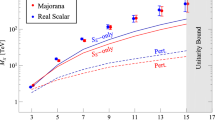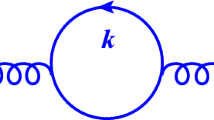Abstract
Left–right symmetric gauge theory presents a minimal paradigm to accommodate massive neutrinos with all the known conserved symmetries duly gauged. The work presented here is based on the argument that the see-saw mechanism does not force the new right-handed symmetry scale to be very high, and as such some of the species from the spectrum of the new gauge and Higgs bosons can have masses within a few orders of magnitude of the TeV scale. The scale of the left–right parity breaking in turn can be sequestered from the Planck scale by supersymmetry. We have studied several formulations of such just beyond Standard Model (JBSM) theories for their consistency with cosmology. Specifically, the need to eliminate phenomenologically undesirable domain walls gives many useful clues. The possibility that the exact left–right symmetry breaks in conjunction with supersymmetry has been explored in the context of gauge mediation, placing restrictions on the available parameter space. Finally, we have also studied a left–right symmetric model in the context of metastable supersymmetric vacua and obtained constraints on the mass scale of right-handed symmetry. In all the cases studied, the mass scale of the right-handed neutrino \(M_\mathrm{R}\) remains bounded from above, and in some of the cases the scale \(10^9\) GeV favourable for supersymmetric thermal leptogenesis is disallowed. On the other hand, PeV scale remains a viable option, and the results warrant a more detailed study of such models for their observability in collider and astroparticle experiments.
Similar content being viewed by others
References
K Okumura, EPJ Web Conf. 126, 02023 (2016)
Super-Kamiokande Collaboration: Y Fukuda et al, Phys. Rev. Lett. 81, 1562 (1998)
R Davis, B T Cleveland and J K Rowley, AIP Conf. Proc. 123, 1037 (1984)
SNO Collaboration: Q R Ahmed et al, Phys. Rev. Lett. 89, 011301 (2002) J N Bahcall and C Pena-Garay, arXiv:hep-ph/0404061
A B McDonald, Ann. Phys. 528, 469 (2016)
Z Poh and S Raby, Phys. Rev. D 92, 015017 (2015)
C S Aulakh and A Girdhar, Int. J. Mod. Phys. A 20, 865 (2005)
C S Aulakh and A Girdhar, Nucl. Phys. B 711, 275 (2005)
K Lane and L Pritchett, arXiv:1604.07085 [hep-ph]
R K Kaul, Rev. Mod. Phys. 55, 449 (1983)
C Csaki, J Hubisz, G D Kribs, P Meade and J Terning, Phys. Rev. D 68, 035009 (2003)
D E Kaplan and M Schmaltz, J. High Energy Phys. 0310, 039 (2003)
N Arkani-Hamed, A G Cohen, E Katz, A E Nelson, T Gregoire and J G Wacker, J. High Energy Phys. 0208, 021 (2002)
V A Kuzmin, V A Rubakov and M E Shaposhnikov, Phys. Lett. B 155, 36 (1985) P A Arnold and L McLerran, Phys. Rev. D 36, 581 (1987); Phys. Rev. D 36, 1020 (1988) J Ambjorn, T Askgaard, H Porter and M E Shaposhnikov, Phys. Lett. B 244, 479 (1990); Nucl. Phys. B 353, 346 (1991)
M Joyce, T Prokopec and N Turok, Phys. Rev. Lett. 75, 1695 (1995); Erratum, ibid. 75, 3375 (1995) J Cline, M Joyce and K Kainulainen, Phys. Lett. B 417, 79 (1998) J Cline and K Kainulainen, Phys. Rev. Lett. 85, 5519 (2000)
M Fukugita and T Yanagida, Phys. Lett. B 174, 45 (1986) M A Luty, Phys. Rev. D 45, 455 (1992) M Plumacher, Z. Phys. C 74, 549 (1997)
S Davidson and A Ibarra, Phys. Lett. B 535, 25 (2002) W Buchmuller, P Di Bari and M Plumacher, Nucl. Phys. B 643, 367 (2002) S Antusch and S F King, Phys. Lett. B 597, 199 (2004) N Sahu and S Uma Sankar, Phys. Rev. D 71, 013006 (2005)
M A Luty, Phys. Rev. D 45, 455 (1992) M Plumacher, Z. Phys. C 74, 549 (1997) W Buchmuller, P Di Bari and M Plumacher, Nucl. Phys. B 643, 367 (2002) G F Giudice, A Notari, M Raidal, A Riotto and A Strumia, Nucl. Phys. B 685, 89 (2004)
N Sahu and U A Yajnik, Phys. Rev. D 71, 023507 (2005)
M Gell-Mann, P Ramond and R Slansky, Conf. Proc. C 790927, 315 (1979), arXiv:1306.4669 [hep-th]
T Yanagida, Conf. Proc. C 7902131, 95 (1979)
R N Mohapatra and G Senjanovic, Phys. Rev. Lett. 44, 912 (1980)
J Schechter and J W F Valle, Phys. Rev. D 22, 2227 (1980)
J Schechter and J W F Valle, Phys. Rev. D 25, 774 (1982)
J C Pati and A Salam, Phys. Rev. D 10, 275 (1974) R N Mohapatra and J C Pati, Phys. Rev. D 11, 566 (1975); Phys. Rev. D 11, 2558 (1975) R N Mohapatra and G Senjanovic, Phys. Rev. D 12, 1502 (1975)
H Davoudiasl and Y Zhang, Phys. Rev. D 92, 016005 (2015)
P S B Dev and R N Mohapatra, Phys. Rev. D 92, 016007 (2015)
M Chala, G Nardini and I Sobolev, Phys. Rev. D 94, 055006 (2016)
L Covi, J E Kim, B Kyae and S Nam, Phys. Rev. D 94, 065004 (2016)
D Zhuridov, Phys. Rev. D 94, 035007 (2016)
F P Huang, P H Gu, P F Yin, Z H Yu and X Zhang, Phys. Rev. D 93, 103515 (2016)
M Dhuria, C Hati and U Sarkar, Phys. Lett. B 756, 376 (2016)
F F Deppisch, J Harz, M Hirsch, W C Huang and H Ps, Phys. Rev. D 92, 036005 (2015)
F P Huang, Y Wan, D G Wang, Y F Cai and X Zhang, Phys. Rev. D 94, 041702 (2016)
NNbar Collaboration: M J Frost, arXiv:1607.07271 [hep-ph]
W Dekens, J de Vries, J Bsaisou, W Bernreuther, C Hanhart, U G Meiner, A Nogga and A Wirzba, J. High Energy Phys. 1407, 069 (2014)
V Cirigliano, W Dekens, J de Vries and E Mereghetti, Phys. Lett. B 767, 1 (2017)
M Drewes and S Eijima, arXiv:1606.06221 [hep-ph]
T Asaka, S Eijima and H Ishida, Phys. Lett. B 762, 371 (2016)
SHiP Collaboration: M De Serio, J. Phys. Conf. Ser. 718, 062015 (2016)
ILC Collaboration: G Aarons et al, arXiv:0709.1893 [hep-ph]
A Pilaftsis and T E J Underwood, Phys. Rev. D 72, 113001 (2005)
P S Bhupal Dev, P Millington, A Pilaftsis and D Teresi, Nucl. Part. Phys. Proc. 273–275, 268 (2016)
I Affleck and M Dine, Nucl. Phys. B 249, 361 (1985)
R Allahverdi, M Cicoli and F Muia, J. High Energy Phys. 1606, 153 (2016)
J M Cline, U A Yajnik, S N Nayak and M Rabikumar, Phys. Rev. D 66, 065001 (2002)
A Sarkar, Abhishek and U A Yajnik, Nucl. Phys. B 800, 253 (2008), arXiv: 0710.5410
R N Mohapatra and R E Marshak, Phys. Rev. Lett. 44, 1316 (1980)
R Kuchimanchi and R N Mohapatra, Phys. Rev. D 48, 4352 (1993)
R Kuchimanchi and R N Mohapatra, Phys. Rev. Lett. 75, 3989 (1995)
C S Aulakh, K Benakli and G Senjanovic, Phys. Rev. Lett. 79, 2188 (1997)
C S Aulakh, A Melfo, A Rasin and G Senjanovic, Phys. Rev. D 58, 115007 (1998)
C S Aulakh, A Melfo and G Senjanovic, Phys. Rev. D 57, 4174 (1998)
N Sahu and U A Yajnik, Phys. Rev. D 71, 023507 (2005)
K S Babu and R N Mohapatra, Phys. Lett. B 668, 404 (2008), arXiv: 0807.0481
T W B Kibble, Phys. Rep. 67, 183 (1980)
M Kawasaki and F Takahashi, Phys. Lett. B 618, 1 (2005)
S Mishra and U A Yajnik, Phys. Rev. D 81, 045010 (2010)
B Rai and G Senjanovic, Phys. Rev. D 49, 2729 (1994)
J Preskill, S P Trivedi, F Wilczek and M B Wise, Nucl. Phys. B 363, 207 (1991)
A Sarkar and U A Yajnik, Phys. Rev. D 76, 025001 (2007)
S Mishra, U A Yajnik and A Sarkar, Phys. Rev. D 79, 065038 (2009)
S L Dubovsky, D S Gorbunov and S V Troitsky, Phys. Usp. 42, 623 (1999)
S Knapen and D Redigolo, arXiv:1606.07501 [hep-ph]
B C Allanach, M Badziak, G Cottin, N Desai, C Hugonie and R Ziegler, Eur. Phys. J. C 76, 482 (2016)
A E Nelson and N Seiberg, Nucl. Phys. B 416, 46 (1994)
N Seiberg, Nucl. Phys. B 435, 129 (1995)
K A Intriligator, N Seiberg and D Shih, J. High Energy Phys. 0604, 021 (2006),
K A Intriligator, N Seiberg and D Shih, J. High Energy Phys. 0707, 017 (2007)
N Haba and H Ohki, J. High Energy Phys. 1108, 021 (2011)
D Borah and U A Yajnik, J. High Energy Phys. 1112, 072 (2011)
J Kopp, M Lindner, V Niro and T E J Underwood, Phys. Rev. D 81, 025008 (2010)
D Borah and U A Yajnik, Phys. Rev. D 83, 095004 (2011)
Acknowledgements
This is a comprehensive resume of the work done jointly with Narendra Sahu, Anjishnu Sarkar, Sasmita Mishra and Debasish Borah. It is a happy duty to thank the collaborators. The coverage of other works along similar lines suffers from the limitation of space permitted here as also from limitation of the author’s awareness of them. Most of the work was supported by grants from Department of Science and Technology. The author would like to thank the organizers of the Pheno1 Conference, IISER Mohali and the organizers and participants of the program Exploring the Energy Ladder of the Universe for enabling presentation and discussion of this work. The author would like to express special thanks to the Mainz Institute for Theoretical Physics (MITP) for its hospitality and support.
Author information
Authors and Affiliations
Corresponding author
Rights and permissions
About this article
Cite this article
Yajnik, U.A. Why PeV scale left–right symmetry is a good thing. Pramana - J Phys 89, 59 (2017). https://doi.org/10.1007/s12043-017-1461-5
Published:
DOI: https://doi.org/10.1007/s12043-017-1461-5




